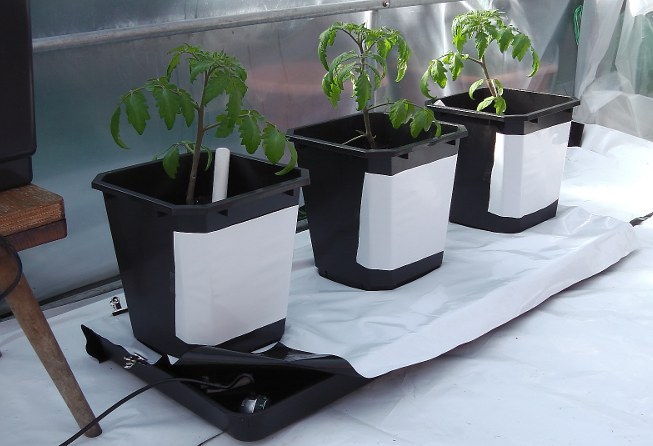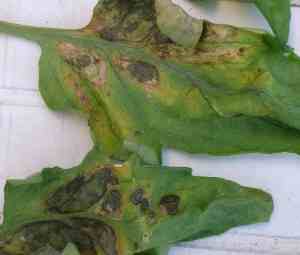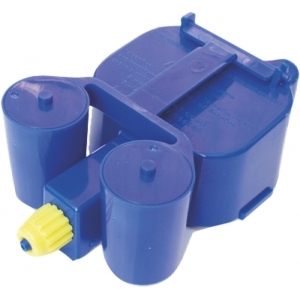Given the great spell of weather we had recently in the UK, here are some of the problems that too much direct sunlight can have on our tomatoes!
Too much sun and heat can effect fruit
Three common tomato problems are:
- Blotchy ripening,
- Sunscald
- Greenback.
Blotchy ripening
This happens when tomatoes in direct sunlight are unable to produce enough lycopene because of the heat. Lycopene is the red pigment in the skin and flesh of the fruit.
.
Sunscald
This happens when the skin is damaged and a pale brown papery patch appears on the sunny side. It looks similar to BER but lighter in colour and on the side of the fruit.
.
Greenback
The shoulders of the fruit fail to ripen – some varieties are more susceptible to greenback than others, a few large varieties do it by default, but it is often caused by too much direct sunlight.
Blotchy ripening and greenback can also be caused by a lack of potassium (potash).
To avoid these problems, It’s a good idea to use some shading, such as garden fleece, when the sun is very strong – especially around midday and early afternoon.
Black trays and pots can become very hot, so attaching white reflective material to the front of containers is helpful.

A bucket of water over the patio slabs or on the floor of the greenhouse will cool things down slightly and help flowers set if the air is very dry.
One issue with growing tomatoes outdoors in the UK is that we can get all four seasons packed into one summer – it’s difficult to prepare for every possibility!
They say that prevention is better than cure – when it comes to tomato plants, that’s definitely true!
Here are my top tips for keeping your plants healthy and quick growing, which means that you’ll have a great crop sooner rather than later!
Keep Leaves Dry
A mix of warm conditions and wet weather is ideal for blight, early and late blight, so it’s good to keep leaves dry if possible. Fungal spores, including blight, find it difficult to attack dry leaves.
Wet plants may become nutrient deficient.
Also, when plants are wet for long periods, they cannot release moisture from their leaves and draw up nutrients through their roots.

Air Flow In The Greenhouse
Good aeration is important – not a problem when growing outside, but in the greenhouse it’s essential to keep a good “turn over” of fresh air. This allows a replenishment of carbon dioxide which plants absorb and good air circulation helps prevent disease too – especially the fungal diseases.
Pruning
It’s good to remove the bottom leaf branches on tall varieties. This allows more air movement around the base of plants where stem rot and other problems, including aphids, may be lurking! See last week’s newsletter on pruning.
Healthy Roots
One part of a tomato plant we don’t often see is the roots and what’s happening below the soil surface.
Friendly Bacteria
There are two types of bacteria that roots come in contact with.
- Good bacteria that actually protect the roots and help them absorb nutrients.
- Harmful bacteria that attack roots and slow the growth of a plant.
Good bacteria increase in well aerated rich soil.
Harmful bacteria increase in saturated, badly drained soil containing little or no oxygen.
Watering
Not only do good bacteria increase when there is plenty of oxygen in the soil but roots need oxygen too – plants grow more quickly if they are not over watered.
The standard advice is to keep soil “just moist”. Of course that’s almost impossible to do, because when we water soil, it goes from very wet to almost dry, within a few hours, on a hot day!
It’s good to think of watering as a “see saw” between water and air … when watered, soil contains more water – as the moisture is absorbed by a plant, or evaporates, air is drawn back in between the soil particles.

This is known as the “Wet/Dry Cycle” where plant roots can receive both the water/nutrients and the oxygen they need as the soil dries (friendly bacteria also receive oxygen) for healthy roots and speedy, strong growth. Of course the soil should never dry out completely or Blossom End Rot will be waiting to strike!
Thankfully, tomato plants grow very quickly in good growing conditions, so we never have to wait too long to get a crop.
When we are aware of the likely problems that may arise throughout the season, we can try to avoid them before they become a serious problem. Prevention is always better than cure!
Regards,
Nick

Rhys Jaggar
Ate the first tomatoes of the season this week, as ever Red Alert and Maskotka compete for the prize. It really is amazing eating carrots and tomatoes from the garden in late June on the salad table.
I must say Nick, I started putting friendly bacteria in my growing medium, from the earliest stages of growth (in the 8cm pots I prick out into at the ten day stage), along with a smidgen of volcanic rock dust and friendly fungi this year. I also threw in some Nutrimate at final potting stage with a bit of Vitax Q4 slow release fertiliser. The speed and frequency of truss formation and fruit set this year has been phenomenal. Not sure which of that bunch of goodies is primarily responsible or whether the warm June weather this year did it. But I have never seen quicker or more frequent truss formation/fruit set.
As for BER, my list of strains seemingly immune include: Shirley, Alicante & Tigerella as salad strains; Maskotka, Black Cherry and Sungold F1 as cherries; and Super Marmande and Black Russian as beefsteaks.
San Marzano, Black Krim seem to get it, Zenith has had it in previous years in Rhizopots but does not suffer in a Quadgrow. I may need a second Quadgrow to grow San Marzanos in future….
Temperatures appear to be set fair again as perfect growing conditions until the end of the month, although we could do with some downpours for other vegetables: very few rainy days here since early March.
This is looking like a great season for several of my plants, particularly Tigerella, Black Cherry, maskotka, Super Marmande and Zenith.
Thanks as always for the weekly sermon – much appreciated!
Nick
All I can say to that is Amen!
I think the Quadgrow should help avoid BER with moisture on tap 24/7.
It is often difficult to know how much a product has contributed to a successful crop without a lot of testing, especially if the weather has been favourable.
I’m pleased it’s all going so well this season!
Leroy from Keoma, Alberta, Canada
Thx Nick for all your helpful tips. Keep it up.
Nick
Will do Leroy – I’m pleased you have found the tips helpful.
Chris
Very helpful as always Nick……these bulletins are always appreciated
Nick
You’re welcome!